NUR222: Legal and Ethical Responsibilities in Nursing - Case Analysis
VerifiedAdded on 2022/10/12
|14
|3904
|208
Report
AI Summary
This report, prepared for a nursing course, addresses the legal and ethical responsibilities of nurses and student nurses through the analysis of three case studies. The first case examines patient consent and the role of a student nurse in the operating room, highlighting ethical considerations and legal requirements regarding patient autonomy. The second case focuses on the importance of hand hygiene and infection control within a healthcare setting, discussing the implications of non-compliance with ethical and legal standards. The third case study explores professional misconduct involving drug use by nurses, emphasizing the importance of maintaining professional standards and ethical conduct. Each case study includes reflections on the legal requirements for different nursing roles, implications for healthcare facilities, and personal experiences to illustrate the application of ethical principles and legal guidelines. The report concludes by summarizing the key takeaways from each case, emphasizing the importance of adhering to ethical and legal standards in nursing practice to ensure patient safety and professional integrity. The report draws on relevant legislation, professional codes, and practice standards to support its analysis and recommendations.
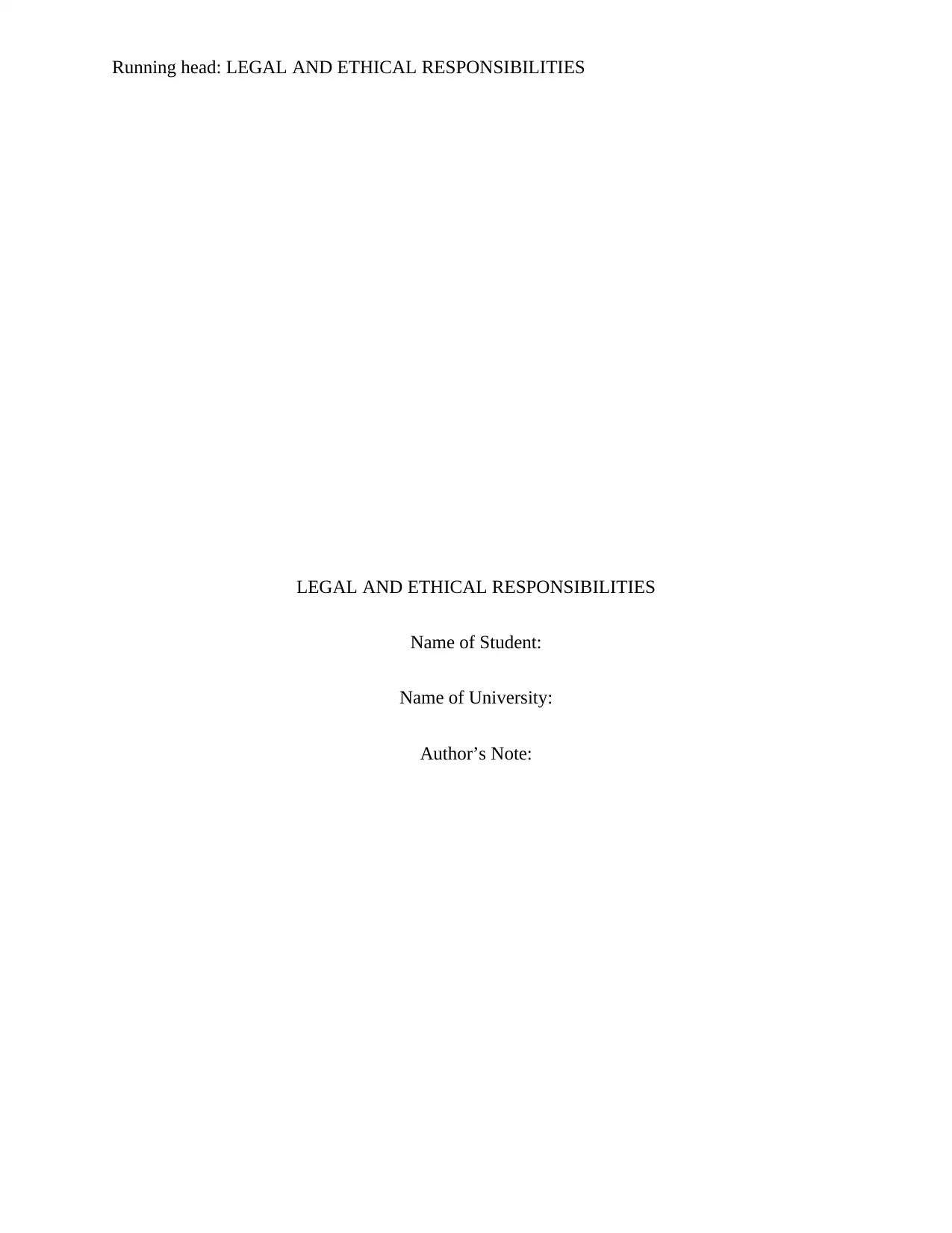
Running head: LEGAL AND ETHICAL RESPONSIBILITIES
LEGAL AND ETHICAL RESPONSIBILITIES
Name of Student:
Name of University:
Author’s Note:
LEGAL AND ETHICAL RESPONSIBILITIES
Name of Student:
Name of University:
Author’s Note:
Paraphrase This Document
Need a fresh take? Get an instant paraphrase of this document with our AI Paraphraser
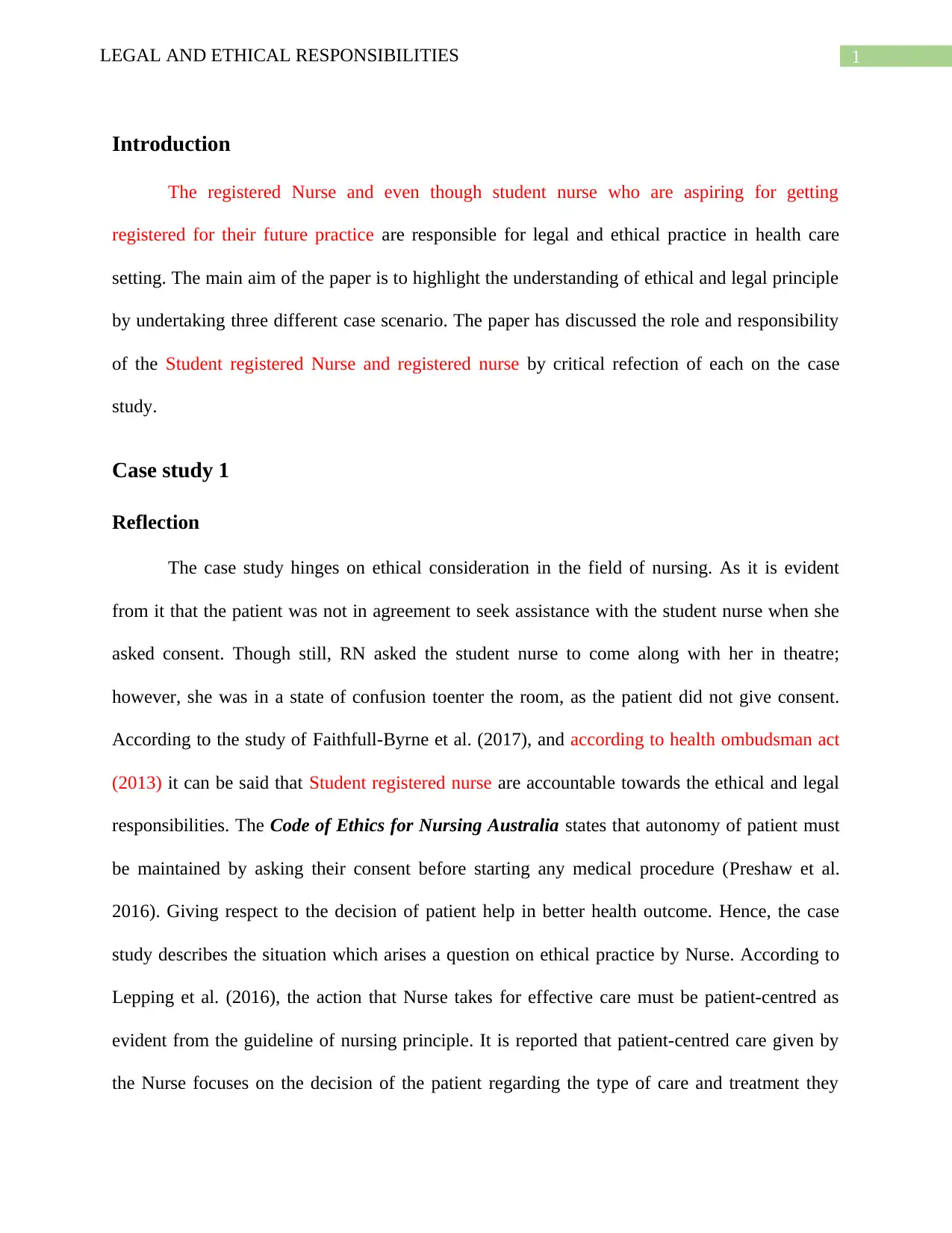
1LEGAL AND ETHICAL RESPONSIBILITIES
Introduction
The registered Nurse and even though student nurse who are aspiring for getting
registered for their future practice are responsible for legal and ethical practice in health care
setting. The main aim of the paper is to highlight the understanding of ethical and legal principle
by undertaking three different case scenario. The paper has discussed the role and responsibility
of the Student registered Nurse and registered nurse by critical refection of each on the case
study.
Case study 1
Reflection
The case study hinges on ethical consideration in the field of nursing. As it is evident
from it that the patient was not in agreement to seek assistance with the student nurse when she
asked consent. Though still, RN asked the student nurse to come along with her in theatre;
however, she was in a state of confusion toenter the room, as the patient did not give consent.
According to the study of Faithfull-Byrne et al. (2017), and according to health ombudsman act
(2013) it can be said that Student registered nurse are accountable towards the ethical and legal
responsibilities. The Code of Ethics for Nursing Australia states that autonomy of patient must
be maintained by asking their consent before starting any medical procedure (Preshaw et al.
2016). Giving respect to the decision of patient help in better health outcome. Hence, the case
study describes the situation which arises a question on ethical practice by Nurse. According to
Lepping et al. (2016), the action that Nurse takes for effective care must be patient-centred as
evident from the guideline of nursing principle. It is reported that patient-centred care given by
the Nurse focuses on the decision of the patient regarding the type of care and treatment they
Introduction
The registered Nurse and even though student nurse who are aspiring for getting
registered for their future practice are responsible for legal and ethical practice in health care
setting. The main aim of the paper is to highlight the understanding of ethical and legal principle
by undertaking three different case scenario. The paper has discussed the role and responsibility
of the Student registered Nurse and registered nurse by critical refection of each on the case
study.
Case study 1
Reflection
The case study hinges on ethical consideration in the field of nursing. As it is evident
from it that the patient was not in agreement to seek assistance with the student nurse when she
asked consent. Though still, RN asked the student nurse to come along with her in theatre;
however, she was in a state of confusion toenter the room, as the patient did not give consent.
According to the study of Faithfull-Byrne et al. (2017), and according to health ombudsman act
(2013) it can be said that Student registered nurse are accountable towards the ethical and legal
responsibilities. The Code of Ethics for Nursing Australia states that autonomy of patient must
be maintained by asking their consent before starting any medical procedure (Preshaw et al.
2016). Giving respect to the decision of patient help in better health outcome. Hence, the case
study describes the situation which arises a question on ethical practice by Nurse. According to
Lepping et al. (2016), the action that Nurse takes for effective care must be patient-centred as
evident from the guideline of nursing principle. It is reported that patient-centred care given by
the Nurse focuses on the decision of the patient regarding the type of care and treatment they
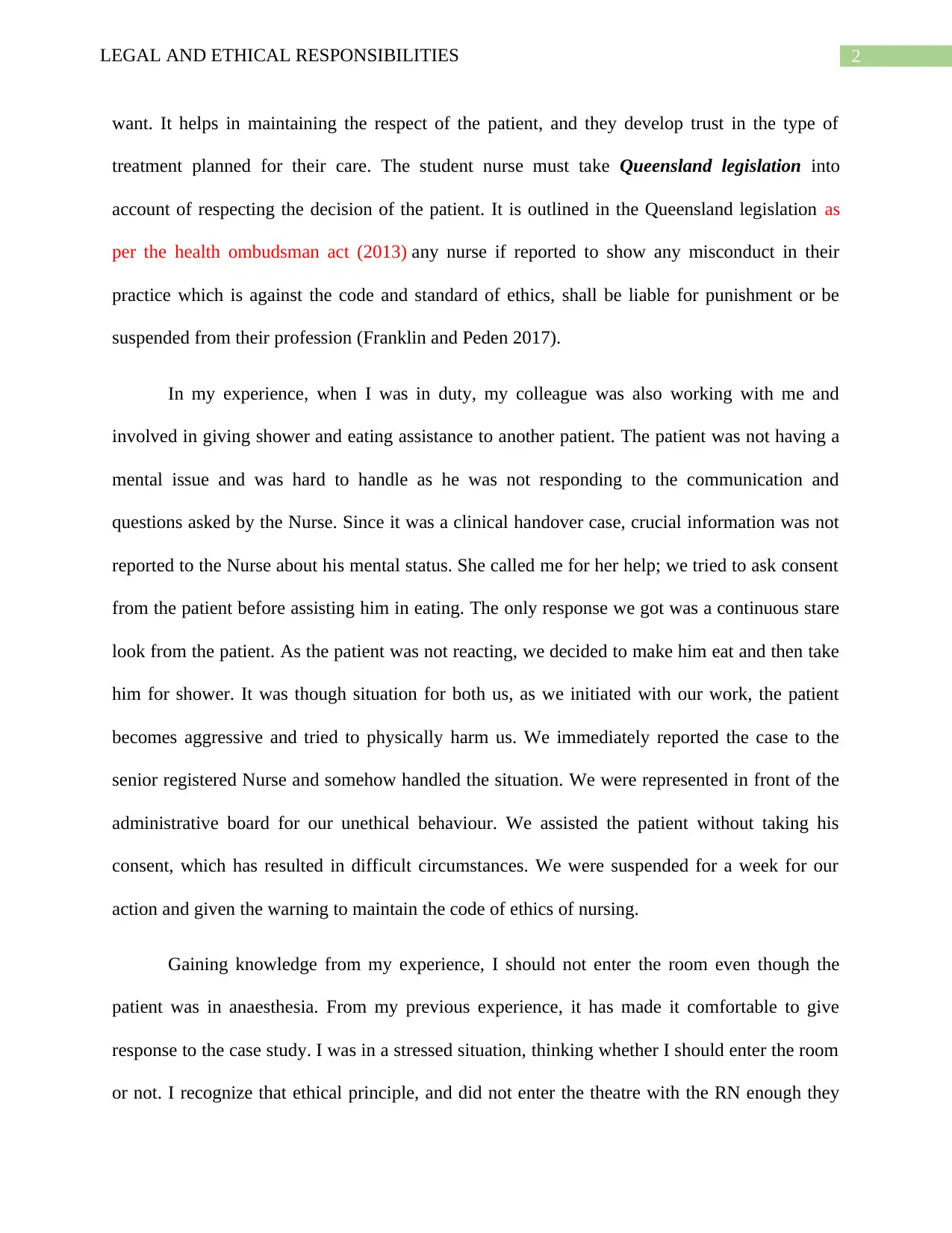
2LEGAL AND ETHICAL RESPONSIBILITIES
want. It helps in maintaining the respect of the patient, and they develop trust in the type of
treatment planned for their care. The student nurse must take Queensland legislation into
account of respecting the decision of the patient. It is outlined in the Queensland legislation as
per the health ombudsman act (2013) any nurse if reported to show any misconduct in their
practice which is against the code and standard of ethics, shall be liable for punishment or be
suspended from their profession (Franklin and Peden 2017).
In my experience, when I was in duty, my colleague was also working with me and
involved in giving shower and eating assistance to another patient. The patient was not having a
mental issue and was hard to handle as he was not responding to the communication and
questions asked by the Nurse. Since it was a clinical handover case, crucial information was not
reported to the Nurse about his mental status. She called me for her help; we tried to ask consent
from the patient before assisting him in eating. The only response we got was a continuous stare
look from the patient. As the patient was not reacting, we decided to make him eat and then take
him for shower. It was though situation for both us, as we initiated with our work, the patient
becomes aggressive and tried to physically harm us. We immediately reported the case to the
senior registered Nurse and somehow handled the situation. We were represented in front of the
administrative board for our unethical behaviour. We assisted the patient without taking his
consent, which has resulted in difficult circumstances. We were suspended for a week for our
action and given the warning to maintain the code of ethics of nursing.
Gaining knowledge from my experience, I should not enter the room even though the
patient was in anaesthesia. From my previous experience, it has made it comfortable to give
response to the case study. I was in a stressed situation, thinking whether I should enter the room
or not. I recognize that ethical principle, and did not enter the theatre with the RN enough they
want. It helps in maintaining the respect of the patient, and they develop trust in the type of
treatment planned for their care. The student nurse must take Queensland legislation into
account of respecting the decision of the patient. It is outlined in the Queensland legislation as
per the health ombudsman act (2013) any nurse if reported to show any misconduct in their
practice which is against the code and standard of ethics, shall be liable for punishment or be
suspended from their profession (Franklin and Peden 2017).
In my experience, when I was in duty, my colleague was also working with me and
involved in giving shower and eating assistance to another patient. The patient was not having a
mental issue and was hard to handle as he was not responding to the communication and
questions asked by the Nurse. Since it was a clinical handover case, crucial information was not
reported to the Nurse about his mental status. She called me for her help; we tried to ask consent
from the patient before assisting him in eating. The only response we got was a continuous stare
look from the patient. As the patient was not reacting, we decided to make him eat and then take
him for shower. It was though situation for both us, as we initiated with our work, the patient
becomes aggressive and tried to physically harm us. We immediately reported the case to the
senior registered Nurse and somehow handled the situation. We were represented in front of the
administrative board for our unethical behaviour. We assisted the patient without taking his
consent, which has resulted in difficult circumstances. We were suspended for a week for our
action and given the warning to maintain the code of ethics of nursing.
Gaining knowledge from my experience, I should not enter the room even though the
patient was in anaesthesia. From my previous experience, it has made it comfortable to give
response to the case study. I was in a stressed situation, thinking whether I should enter the room
or not. I recognize that ethical principle, and did not enter the theatre with the RN enough they
⊘ This is a preview!⊘
Do you want full access?
Subscribe today to unlock all pages.

Trusted by 1+ million students worldwide
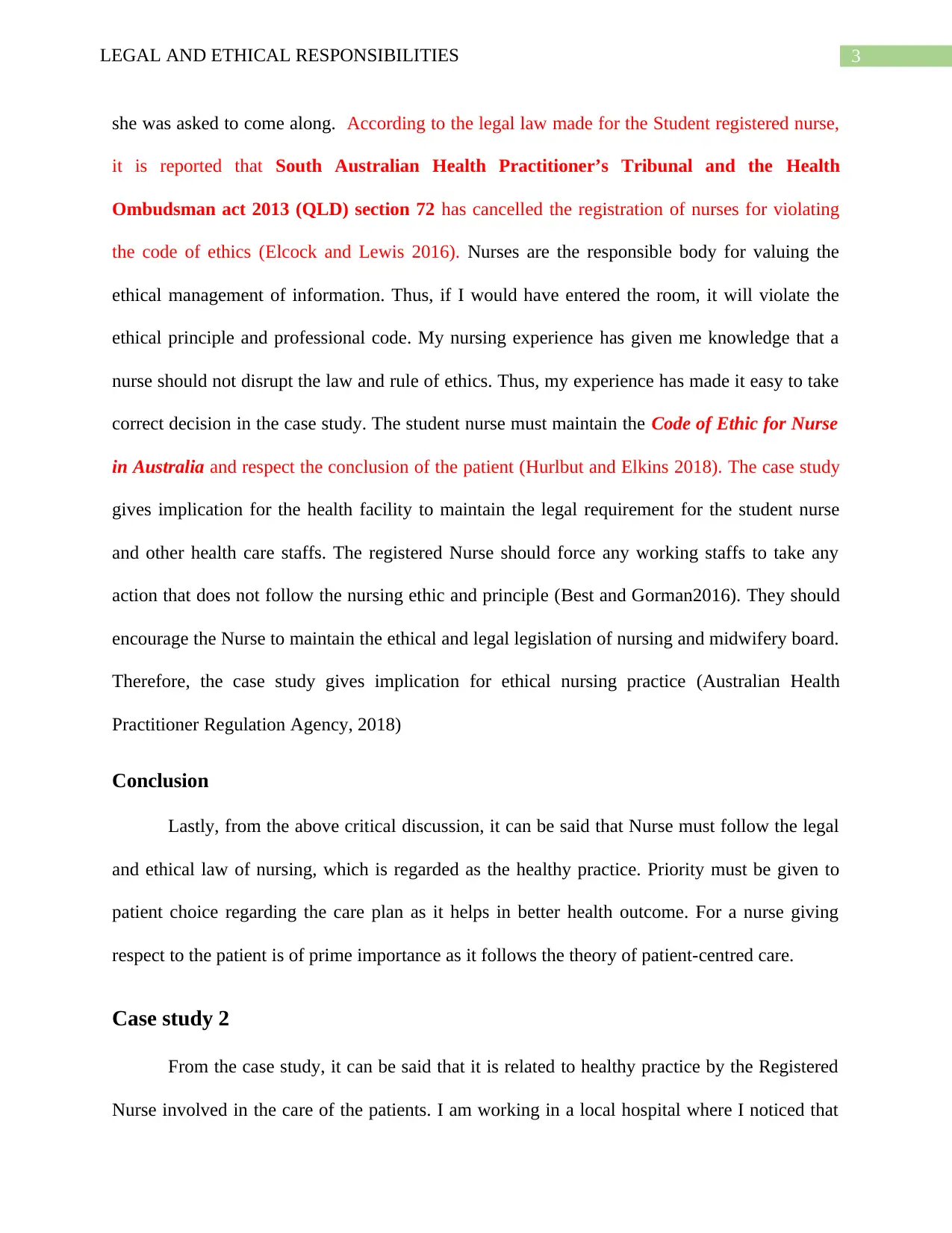
3LEGAL AND ETHICAL RESPONSIBILITIES
she was asked to come along. According to the legal law made for the Student registered nurse,
it is reported that South Australian Health Practitioner’s Tribunal and the Health
Ombudsman act 2013 (QLD) section 72 has cancelled the registration of nurses for violating
the code of ethics (Elcock and Lewis 2016). Nurses are the responsible body for valuing the
ethical management of information. Thus, if I would have entered the room, it will violate the
ethical principle and professional code. My nursing experience has given me knowledge that a
nurse should not disrupt the law and rule of ethics. Thus, my experience has made it easy to take
correct decision in the case study. The student nurse must maintain the Code of Ethic for Nurse
in Australia and respect the conclusion of the patient (Hurlbut and Elkins 2018). The case study
gives implication for the health facility to maintain the legal requirement for the student nurse
and other health care staffs. The registered Nurse should force any working staffs to take any
action that does not follow the nursing ethic and principle (Best and Gorman2016). They should
encourage the Nurse to maintain the ethical and legal legislation of nursing and midwifery board.
Therefore, the case study gives implication for ethical nursing practice (Australian Health
Practitioner Regulation Agency, 2018)
Conclusion
Lastly, from the above critical discussion, it can be said that Nurse must follow the legal
and ethical law of nursing, which is regarded as the healthy practice. Priority must be given to
patient choice regarding the care plan as it helps in better health outcome. For a nurse giving
respect to the patient is of prime importance as it follows the theory of patient-centred care.
Case study 2
From the case study, it can be said that it is related to healthy practice by the Registered
Nurse involved in the care of the patients. I am working in a local hospital where I noticed that
she was asked to come along. According to the legal law made for the Student registered nurse,
it is reported that South Australian Health Practitioner’s Tribunal and the Health
Ombudsman act 2013 (QLD) section 72 has cancelled the registration of nurses for violating
the code of ethics (Elcock and Lewis 2016). Nurses are the responsible body for valuing the
ethical management of information. Thus, if I would have entered the room, it will violate the
ethical principle and professional code. My nursing experience has given me knowledge that a
nurse should not disrupt the law and rule of ethics. Thus, my experience has made it easy to take
correct decision in the case study. The student nurse must maintain the Code of Ethic for Nurse
in Australia and respect the conclusion of the patient (Hurlbut and Elkins 2018). The case study
gives implication for the health facility to maintain the legal requirement for the student nurse
and other health care staffs. The registered Nurse should force any working staffs to take any
action that does not follow the nursing ethic and principle (Best and Gorman2016). They should
encourage the Nurse to maintain the ethical and legal legislation of nursing and midwifery board.
Therefore, the case study gives implication for ethical nursing practice (Australian Health
Practitioner Regulation Agency, 2018)
Conclusion
Lastly, from the above critical discussion, it can be said that Nurse must follow the legal
and ethical law of nursing, which is regarded as the healthy practice. Priority must be given to
patient choice regarding the care plan as it helps in better health outcome. For a nurse giving
respect to the patient is of prime importance as it follows the theory of patient-centred care.
Case study 2
From the case study, it can be said that it is related to healthy practice by the Registered
Nurse involved in the care of the patients. I am working in a local hospital where I noticed that
Paraphrase This Document
Need a fresh take? Get an instant paraphrase of this document with our AI Paraphraser
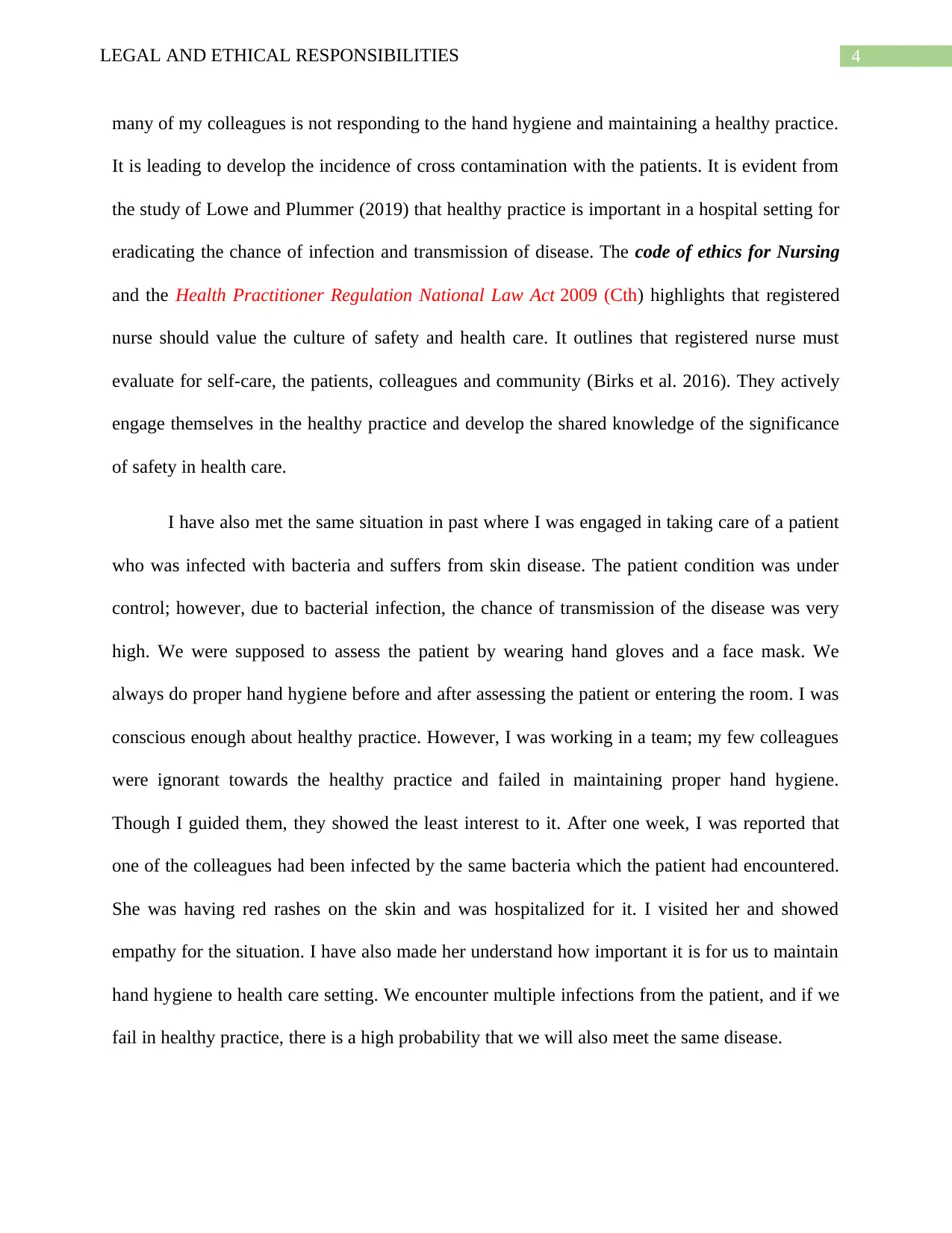
4LEGAL AND ETHICAL RESPONSIBILITIES
many of my colleagues is not responding to the hand hygiene and maintaining a healthy practice.
It is leading to develop the incidence of cross contamination with the patients. It is evident from
the study of Lowe and Plummer (2019) that healthy practice is important in a hospital setting for
eradicating the chance of infection and transmission of disease. The code of ethics for Nursing
and the Health Practitioner Regulation National Law Act 2009 (Cth) highlights that registered
nurse should value the culture of safety and health care. It outlines that registered nurse must
evaluate for self-care, the patients, colleagues and community (Birks et al. 2016). They actively
engage themselves in the healthy practice and develop the shared knowledge of the significance
of safety in health care.
I have also met the same situation in past where I was engaged in taking care of a patient
who was infected with bacteria and suffers from skin disease. The patient condition was under
control; however, due to bacterial infection, the chance of transmission of the disease was very
high. We were supposed to assess the patient by wearing hand gloves and a face mask. We
always do proper hand hygiene before and after assessing the patient or entering the room. I was
conscious enough about healthy practice. However, I was working in a team; my few colleagues
were ignorant towards the healthy practice and failed in maintaining proper hand hygiene.
Though I guided them, they showed the least interest to it. After one week, I was reported that
one of the colleagues had been infected by the same bacteria which the patient had encountered.
She was having red rashes on the skin and was hospitalized for it. I visited her and showed
empathy for the situation. I have also made her understand how important it is for us to maintain
hand hygiene to health care setting. We encounter multiple infections from the patient, and if we
fail in healthy practice, there is a high probability that we will also meet the same disease.
many of my colleagues is not responding to the hand hygiene and maintaining a healthy practice.
It is leading to develop the incidence of cross contamination with the patients. It is evident from
the study of Lowe and Plummer (2019) that healthy practice is important in a hospital setting for
eradicating the chance of infection and transmission of disease. The code of ethics for Nursing
and the Health Practitioner Regulation National Law Act 2009 (Cth) highlights that registered
nurse should value the culture of safety and health care. It outlines that registered nurse must
evaluate for self-care, the patients, colleagues and community (Birks et al. 2016). They actively
engage themselves in the healthy practice and develop the shared knowledge of the significance
of safety in health care.
I have also met the same situation in past where I was engaged in taking care of a patient
who was infected with bacteria and suffers from skin disease. The patient condition was under
control; however, due to bacterial infection, the chance of transmission of the disease was very
high. We were supposed to assess the patient by wearing hand gloves and a face mask. We
always do proper hand hygiene before and after assessing the patient or entering the room. I was
conscious enough about healthy practice. However, I was working in a team; my few colleagues
were ignorant towards the healthy practice and failed in maintaining proper hand hygiene.
Though I guided them, they showed the least interest to it. After one week, I was reported that
one of the colleagues had been infected by the same bacteria which the patient had encountered.
She was having red rashes on the skin and was hospitalized for it. I visited her and showed
empathy for the situation. I have also made her understand how important it is for us to maintain
hand hygiene to health care setting. We encounter multiple infections from the patient, and if we
fail in healthy practice, there is a high probability that we will also meet the same disease.
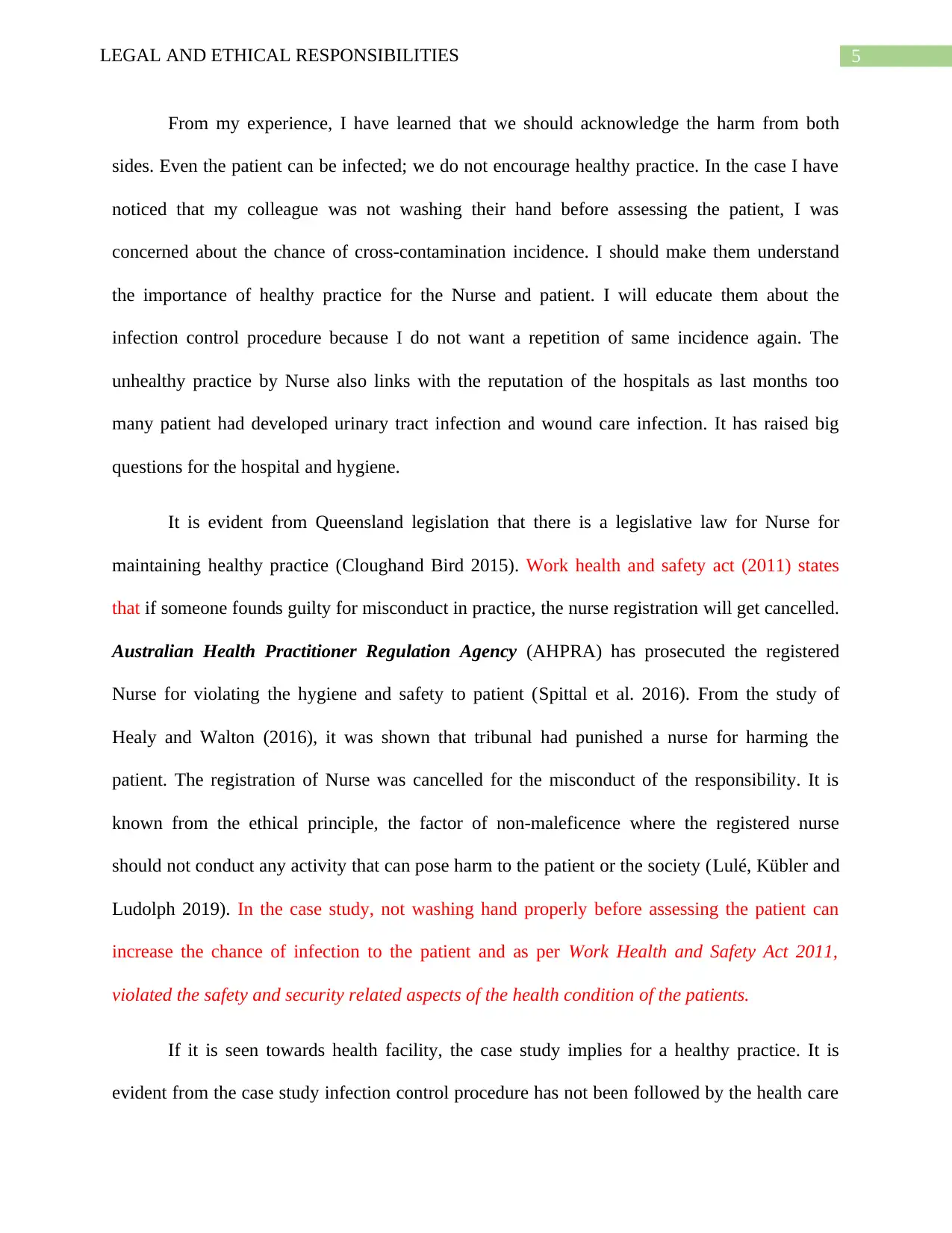
5LEGAL AND ETHICAL RESPONSIBILITIES
From my experience, I have learned that we should acknowledge the harm from both
sides. Even the patient can be infected; we do not encourage healthy practice. In the case I have
noticed that my colleague was not washing their hand before assessing the patient, I was
concerned about the chance of cross-contamination incidence. I should make them understand
the importance of healthy practice for the Nurse and patient. I will educate them about the
infection control procedure because I do not want a repetition of same incidence again. The
unhealthy practice by Nurse also links with the reputation of the hospitals as last months too
many patient had developed urinary tract infection and wound care infection. It has raised big
questions for the hospital and hygiene.
It is evident from Queensland legislation that there is a legislative law for Nurse for
maintaining healthy practice (Cloughand Bird 2015). Work health and safety act (2011) states
that if someone founds guilty for misconduct in practice, the nurse registration will get cancelled.
Australian Health Practitioner Regulation Agency (AHPRA) has prosecuted the registered
Nurse for violating the hygiene and safety to patient (Spittal et al. 2016). From the study of
Healy and Walton (2016), it was shown that tribunal had punished a nurse for harming the
patient. The registration of Nurse was cancelled for the misconduct of the responsibility. It is
known from the ethical principle, the factor of non-maleficence where the registered nurse
should not conduct any activity that can pose harm to the patient or the society (Lulé, Kübler and
Ludolph 2019). In the case study, not washing hand properly before assessing the patient can
increase the chance of infection to the patient and as per Work Health and Safety Act 2011,
violated the safety and security related aspects of the health condition of the patients.
If it is seen towards health facility, the case study implies for a healthy practice. It is
evident from the case study infection control procedure has not been followed by the health care
From my experience, I have learned that we should acknowledge the harm from both
sides. Even the patient can be infected; we do not encourage healthy practice. In the case I have
noticed that my colleague was not washing their hand before assessing the patient, I was
concerned about the chance of cross-contamination incidence. I should make them understand
the importance of healthy practice for the Nurse and patient. I will educate them about the
infection control procedure because I do not want a repetition of same incidence again. The
unhealthy practice by Nurse also links with the reputation of the hospitals as last months too
many patient had developed urinary tract infection and wound care infection. It has raised big
questions for the hospital and hygiene.
It is evident from Queensland legislation that there is a legislative law for Nurse for
maintaining healthy practice (Cloughand Bird 2015). Work health and safety act (2011) states
that if someone founds guilty for misconduct in practice, the nurse registration will get cancelled.
Australian Health Practitioner Regulation Agency (AHPRA) has prosecuted the registered
Nurse for violating the hygiene and safety to patient (Spittal et al. 2016). From the study of
Healy and Walton (2016), it was shown that tribunal had punished a nurse for harming the
patient. The registration of Nurse was cancelled for the misconduct of the responsibility. It is
known from the ethical principle, the factor of non-maleficence where the registered nurse
should not conduct any activity that can pose harm to the patient or the society (Lulé, Kübler and
Ludolph 2019). In the case study, not washing hand properly before assessing the patient can
increase the chance of infection to the patient and as per Work Health and Safety Act 2011,
violated the safety and security related aspects of the health condition of the patients.
If it is seen towards health facility, the case study implies for a healthy practice. It is
evident from the case study infection control procedure has not been followed by the health care
⊘ This is a preview!⊘
Do you want full access?
Subscribe today to unlock all pages.

Trusted by 1+ million students worldwide
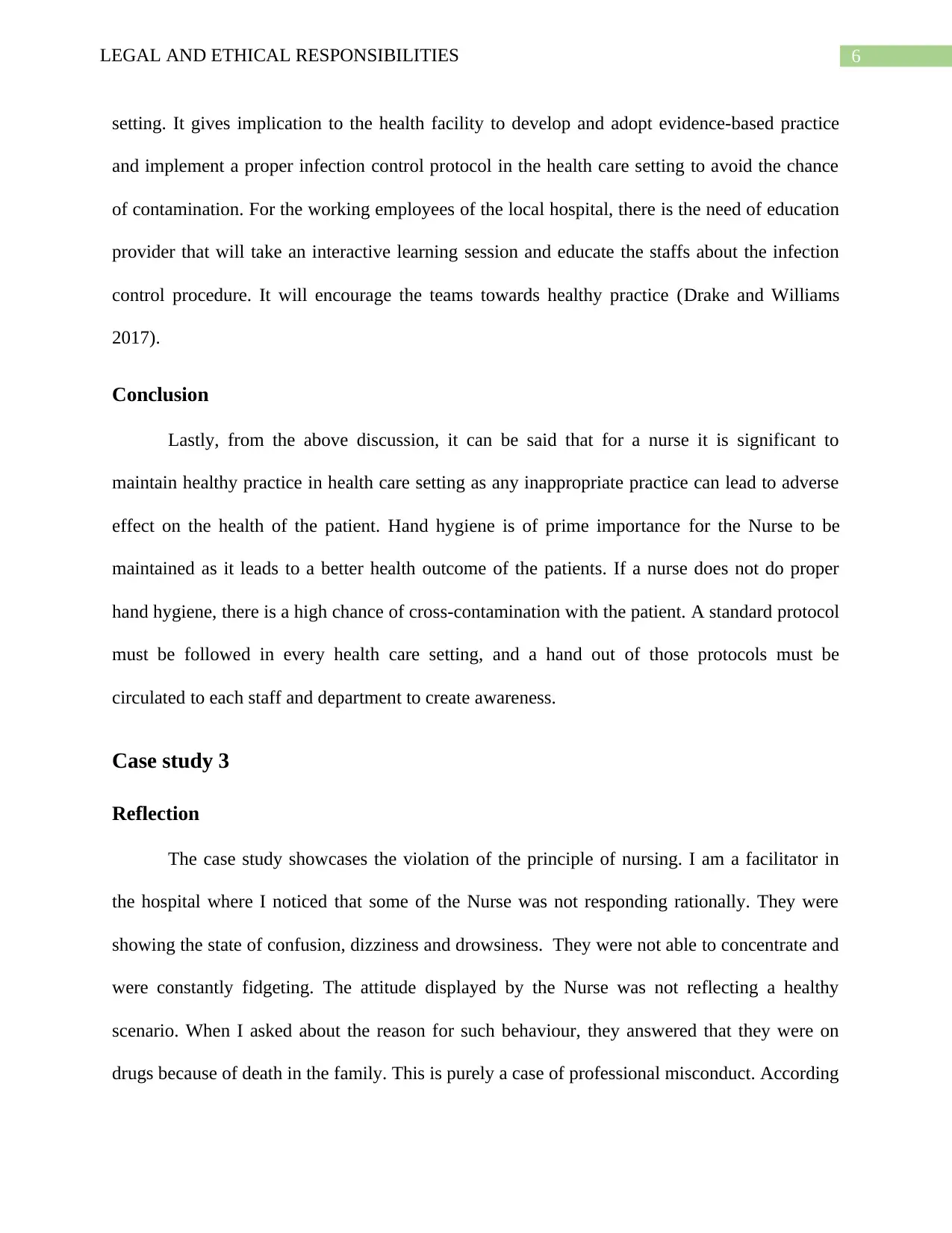
6LEGAL AND ETHICAL RESPONSIBILITIES
setting. It gives implication to the health facility to develop and adopt evidence-based practice
and implement a proper infection control protocol in the health care setting to avoid the chance
of contamination. For the working employees of the local hospital, there is the need of education
provider that will take an interactive learning session and educate the staffs about the infection
control procedure. It will encourage the teams towards healthy practice (Drake and Williams
2017).
Conclusion
Lastly, from the above discussion, it can be said that for a nurse it is significant to
maintain healthy practice in health care setting as any inappropriate practice can lead to adverse
effect on the health of the patient. Hand hygiene is of prime importance for the Nurse to be
maintained as it leads to a better health outcome of the patients. If a nurse does not do proper
hand hygiene, there is a high chance of cross-contamination with the patient. A standard protocol
must be followed in every health care setting, and a hand out of those protocols must be
circulated to each staff and department to create awareness.
Case study 3
Reflection
The case study showcases the violation of the principle of nursing. I am a facilitator in
the hospital where I noticed that some of the Nurse was not responding rationally. They were
showing the state of confusion, dizziness and drowsiness. They were not able to concentrate and
were constantly fidgeting. The attitude displayed by the Nurse was not reflecting a healthy
scenario. When I asked about the reason for such behaviour, they answered that they were on
drugs because of death in the family. This is purely a case of professional misconduct. According
setting. It gives implication to the health facility to develop and adopt evidence-based practice
and implement a proper infection control protocol in the health care setting to avoid the chance
of contamination. For the working employees of the local hospital, there is the need of education
provider that will take an interactive learning session and educate the staffs about the infection
control procedure. It will encourage the teams towards healthy practice (Drake and Williams
2017).
Conclusion
Lastly, from the above discussion, it can be said that for a nurse it is significant to
maintain healthy practice in health care setting as any inappropriate practice can lead to adverse
effect on the health of the patient. Hand hygiene is of prime importance for the Nurse to be
maintained as it leads to a better health outcome of the patients. If a nurse does not do proper
hand hygiene, there is a high chance of cross-contamination with the patient. A standard protocol
must be followed in every health care setting, and a hand out of those protocols must be
circulated to each staff and department to create awareness.
Case study 3
Reflection
The case study showcases the violation of the principle of nursing. I am a facilitator in
the hospital where I noticed that some of the Nurse was not responding rationally. They were
showing the state of confusion, dizziness and drowsiness. They were not able to concentrate and
were constantly fidgeting. The attitude displayed by the Nurse was not reflecting a healthy
scenario. When I asked about the reason for such behaviour, they answered that they were on
drugs because of death in the family. This is purely a case of professional misconduct. According
Paraphrase This Document
Need a fresh take? Get an instant paraphrase of this document with our AI Paraphraser
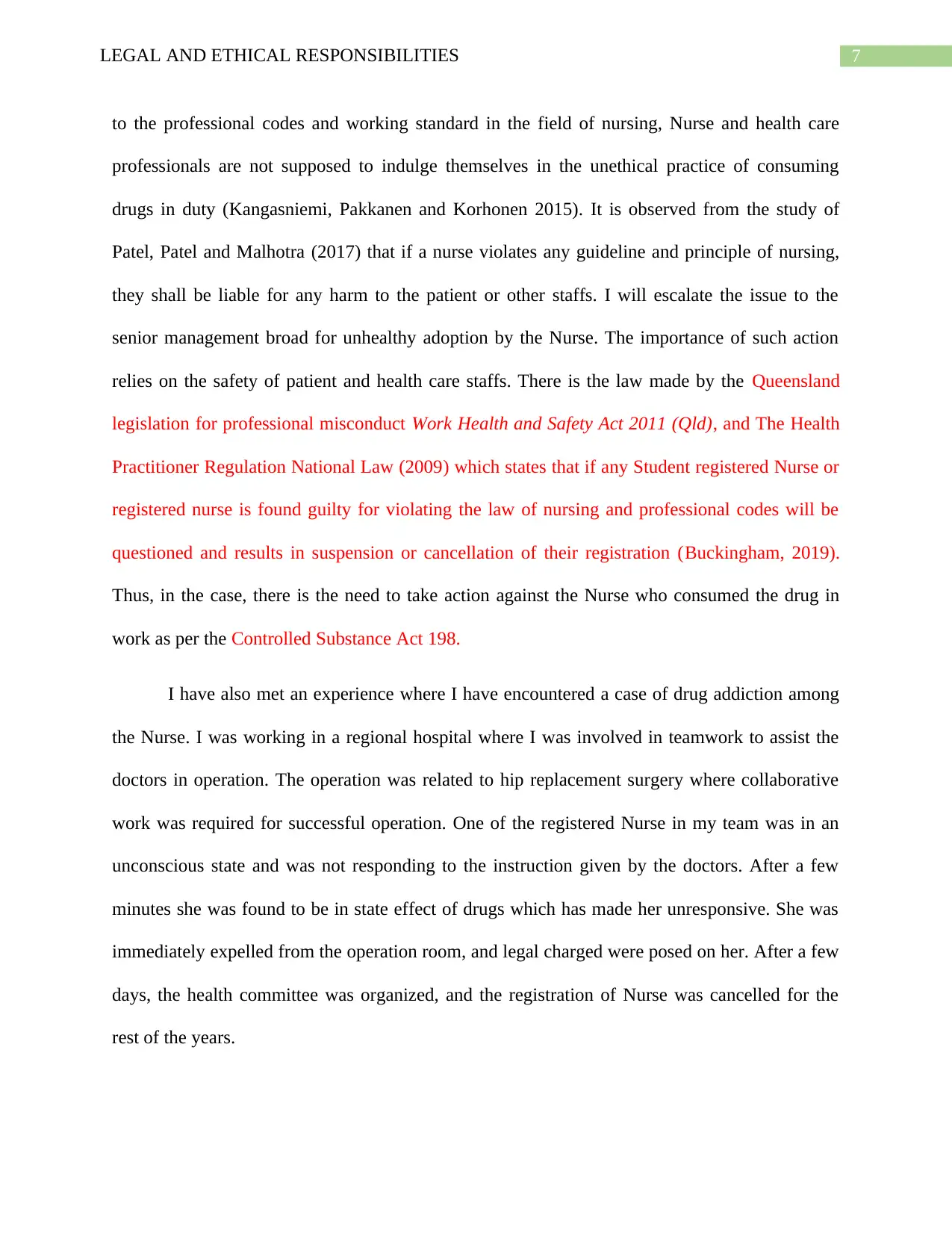
7LEGAL AND ETHICAL RESPONSIBILITIES
to the professional codes and working standard in the field of nursing, Nurse and health care
professionals are not supposed to indulge themselves in the unethical practice of consuming
drugs in duty (Kangasniemi, Pakkanen and Korhonen 2015). It is observed from the study of
Patel, Patel and Malhotra (2017) that if a nurse violates any guideline and principle of nursing,
they shall be liable for any harm to the patient or other staffs. I will escalate the issue to the
senior management broad for unhealthy adoption by the Nurse. The importance of such action
relies on the safety of patient and health care staffs. There is the law made by the Queensland
legislation for professional misconduct Work Health and Safety Act 2011 (Qld), and The Health
Practitioner Regulation National Law (2009) which states that if any Student registered Nurse or
registered nurse is found guilty for violating the law of nursing and professional codes will be
questioned and results in suspension or cancellation of their registration (Buckingham, 2019).
Thus, in the case, there is the need to take action against the Nurse who consumed the drug in
work as per the Controlled Substance Act 198.
I have also met an experience where I have encountered a case of drug addiction among
the Nurse. I was working in a regional hospital where I was involved in teamwork to assist the
doctors in operation. The operation was related to hip replacement surgery where collaborative
work was required for successful operation. One of the registered Nurse in my team was in an
unconscious state and was not responding to the instruction given by the doctors. After a few
minutes she was found to be in state effect of drugs which has made her unresponsive. She was
immediately expelled from the operation room, and legal charged were posed on her. After a few
days, the health committee was organized, and the registration of Nurse was cancelled for the
rest of the years.
to the professional codes and working standard in the field of nursing, Nurse and health care
professionals are not supposed to indulge themselves in the unethical practice of consuming
drugs in duty (Kangasniemi, Pakkanen and Korhonen 2015). It is observed from the study of
Patel, Patel and Malhotra (2017) that if a nurse violates any guideline and principle of nursing,
they shall be liable for any harm to the patient or other staffs. I will escalate the issue to the
senior management broad for unhealthy adoption by the Nurse. The importance of such action
relies on the safety of patient and health care staffs. There is the law made by the Queensland
legislation for professional misconduct Work Health and Safety Act 2011 (Qld), and The Health
Practitioner Regulation National Law (2009) which states that if any Student registered Nurse or
registered nurse is found guilty for violating the law of nursing and professional codes will be
questioned and results in suspension or cancellation of their registration (Buckingham, 2019).
Thus, in the case, there is the need to take action against the Nurse who consumed the drug in
work as per the Controlled Substance Act 198.
I have also met an experience where I have encountered a case of drug addiction among
the Nurse. I was working in a regional hospital where I was involved in teamwork to assist the
doctors in operation. The operation was related to hip replacement surgery where collaborative
work was required for successful operation. One of the registered Nurse in my team was in an
unconscious state and was not responding to the instruction given by the doctors. After a few
minutes she was found to be in state effect of drugs which has made her unresponsive. She was
immediately expelled from the operation room, and legal charged were posed on her. After a few
days, the health committee was organized, and the registration of Nurse was cancelled for the
rest of the years.
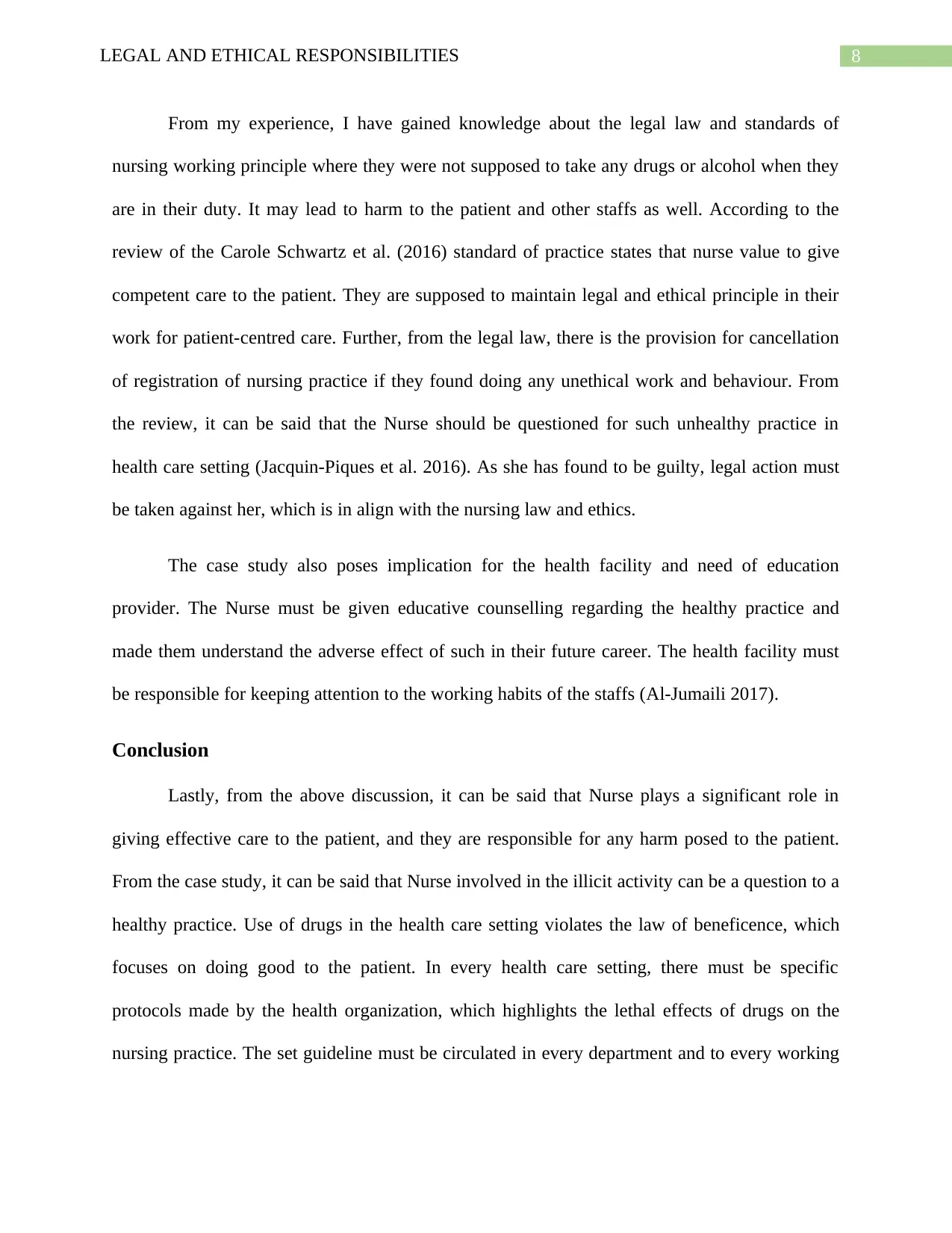
8LEGAL AND ETHICAL RESPONSIBILITIES
From my experience, I have gained knowledge about the legal law and standards of
nursing working principle where they were not supposed to take any drugs or alcohol when they
are in their duty. It may lead to harm to the patient and other staffs as well. According to the
review of the Carole Schwartz et al. (2016) standard of practice states that nurse value to give
competent care to the patient. They are supposed to maintain legal and ethical principle in their
work for patient-centred care. Further, from the legal law, there is the provision for cancellation
of registration of nursing practice if they found doing any unethical work and behaviour. From
the review, it can be said that the Nurse should be questioned for such unhealthy practice in
health care setting (Jacquin-Piques et al. 2016). As she has found to be guilty, legal action must
be taken against her, which is in align with the nursing law and ethics.
The case study also poses implication for the health facility and need of education
provider. The Nurse must be given educative counselling regarding the healthy practice and
made them understand the adverse effect of such in their future career. The health facility must
be responsible for keeping attention to the working habits of the staffs (Al-Jumaili 2017).
Conclusion
Lastly, from the above discussion, it can be said that Nurse plays a significant role in
giving effective care to the patient, and they are responsible for any harm posed to the patient.
From the case study, it can be said that Nurse involved in the illicit activity can be a question to a
healthy practice. Use of drugs in the health care setting violates the law of beneficence, which
focuses on doing good to the patient. In every health care setting, there must be specific
protocols made by the health organization, which highlights the lethal effects of drugs on the
nursing practice. The set guideline must be circulated in every department and to every working
From my experience, I have gained knowledge about the legal law and standards of
nursing working principle where they were not supposed to take any drugs or alcohol when they
are in their duty. It may lead to harm to the patient and other staffs as well. According to the
review of the Carole Schwartz et al. (2016) standard of practice states that nurse value to give
competent care to the patient. They are supposed to maintain legal and ethical principle in their
work for patient-centred care. Further, from the legal law, there is the provision for cancellation
of registration of nursing practice if they found doing any unethical work and behaviour. From
the review, it can be said that the Nurse should be questioned for such unhealthy practice in
health care setting (Jacquin-Piques et al. 2016). As she has found to be guilty, legal action must
be taken against her, which is in align with the nursing law and ethics.
The case study also poses implication for the health facility and need of education
provider. The Nurse must be given educative counselling regarding the healthy practice and
made them understand the adverse effect of such in their future career. The health facility must
be responsible for keeping attention to the working habits of the staffs (Al-Jumaili 2017).
Conclusion
Lastly, from the above discussion, it can be said that Nurse plays a significant role in
giving effective care to the patient, and they are responsible for any harm posed to the patient.
From the case study, it can be said that Nurse involved in the illicit activity can be a question to a
healthy practice. Use of drugs in the health care setting violates the law of beneficence, which
focuses on doing good to the patient. In every health care setting, there must be specific
protocols made by the health organization, which highlights the lethal effects of drugs on the
nursing practice. The set guideline must be circulated in every department and to every working
⊘ This is a preview!⊘
Do you want full access?
Subscribe today to unlock all pages.

Trusted by 1+ million students worldwide
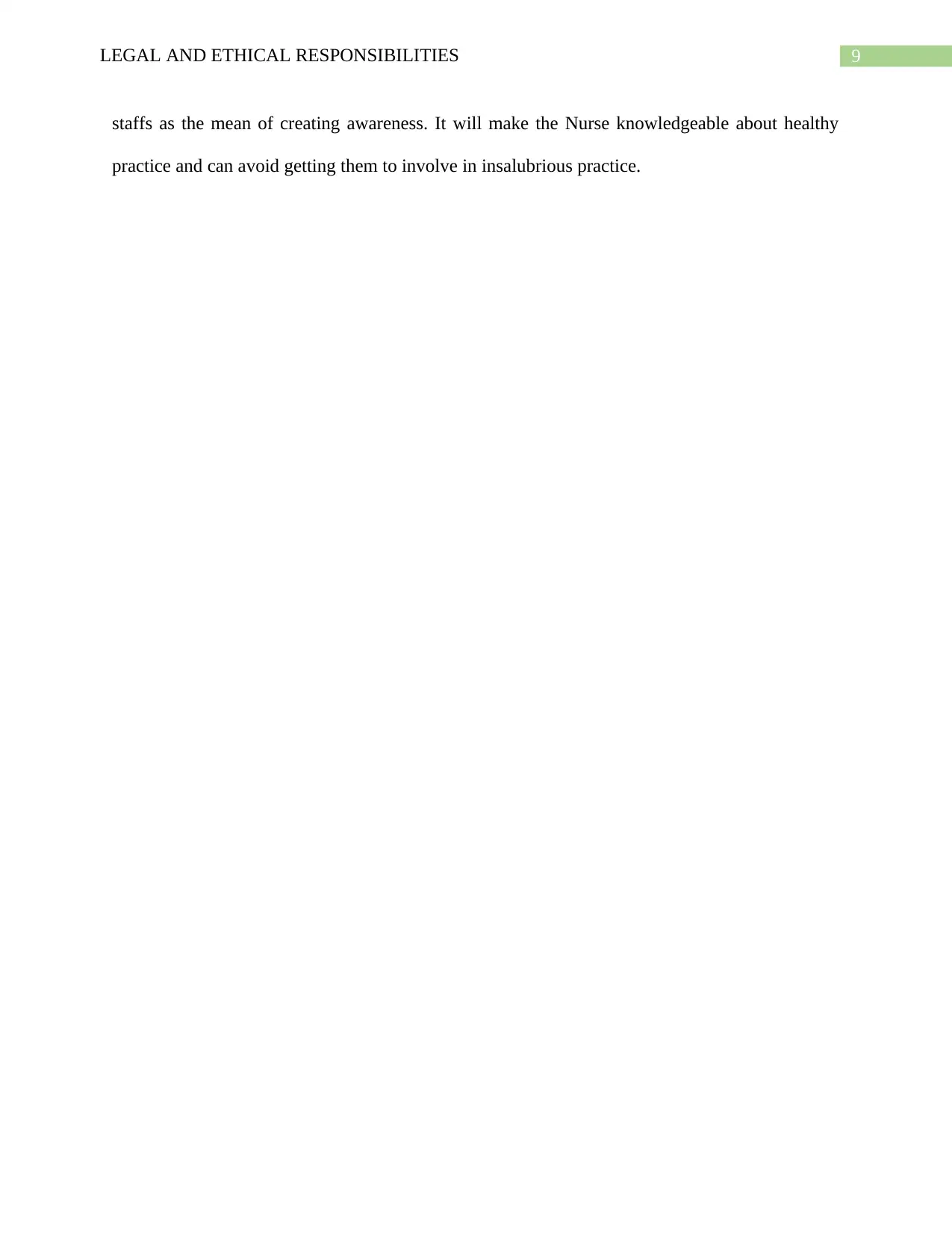
9LEGAL AND ETHICAL RESPONSIBILITIES
staffs as the mean of creating awareness. It will make the Nurse knowledgeable about healthy
practice and can avoid getting them to involve in insalubrious practice.
staffs as the mean of creating awareness. It will make the Nurse knowledgeable about healthy
practice and can avoid getting them to involve in insalubrious practice.
Paraphrase This Document
Need a fresh take? Get an instant paraphrase of this document with our AI Paraphraser

10LEGAL AND ETHICAL RESPONSIBILITIES
Reference
Al-Jumaili, A.A.A., 2017. A systems approach to identify factors influencing prevention,
detection and management of adverse drug events in nursing homes. DOI:
10.17077/etd.y28pyp70
Australian Health Practitioner Regulation Agency., 2018 Australian Health Practitioner
Regulation Agency - Court and Tribunal Decisions. [online] Ahpra.gov.au. Available at:
https://www.ahpra.gov.au/Publications/Tribunal-Decisions.aspx
Best, O. and Gorman, D., 2016. “Some of Us Pushed Forward and Let the World See What
Could Be Done”: Aboriginal Australian Nurses and Midwives, 1900–2005. Labour History: A
Journal of Labour and Social History, (111), pp.149-164. DOI: 10.3828/labourhistory.111.0149
Birks, M., Davis, J., Smithson, J. and Cant, R., 2016. Registered nurse scope of practice in
Australia: an integrative review of the literature. Contemporary Nurse, 52(5), pp.522-543. Doi:
https://doi.org/10.1080/10376178.2016.1238773
Buckingham, J., 2019. A Critical Analysis of Legal Representation in Queensland's Mental
Health Review Tribunal. Griffith Journal of Law & Human Dignity, 6(1). Doi:
https://griffithlawjournal.org/index.php/gjlhd/article/view/1118
Carole Schwartz, M.S., Haines, E., Wallace, J., Smith, B.L., Deutsch, A., Eng, C.T.K., White, E.,
Reilly, K. and Seibert, J.H., 2016. Drug Regimen Review Item Pilot Test for Inpatient
Rehabilitation Facilities, Skilled Nursing Facilities, and Long-Term Care Hospitals. Retrieved
from: http://www.calhospital.org/sites/main/files/file-attachments/drr-item-pilot-test-report-10-6-
16.pdf
Reference
Al-Jumaili, A.A.A., 2017. A systems approach to identify factors influencing prevention,
detection and management of adverse drug events in nursing homes. DOI:
10.17077/etd.y28pyp70
Australian Health Practitioner Regulation Agency., 2018 Australian Health Practitioner
Regulation Agency - Court and Tribunal Decisions. [online] Ahpra.gov.au. Available at:
https://www.ahpra.gov.au/Publications/Tribunal-Decisions.aspx
Best, O. and Gorman, D., 2016. “Some of Us Pushed Forward and Let the World See What
Could Be Done”: Aboriginal Australian Nurses and Midwives, 1900–2005. Labour History: A
Journal of Labour and Social History, (111), pp.149-164. DOI: 10.3828/labourhistory.111.0149
Birks, M., Davis, J., Smithson, J. and Cant, R., 2016. Registered nurse scope of practice in
Australia: an integrative review of the literature. Contemporary Nurse, 52(5), pp.522-543. Doi:
https://doi.org/10.1080/10376178.2016.1238773
Buckingham, J., 2019. A Critical Analysis of Legal Representation in Queensland's Mental
Health Review Tribunal. Griffith Journal of Law & Human Dignity, 6(1). Doi:
https://griffithlawjournal.org/index.php/gjlhd/article/view/1118
Carole Schwartz, M.S., Haines, E., Wallace, J., Smith, B.L., Deutsch, A., Eng, C.T.K., White, E.,
Reilly, K. and Seibert, J.H., 2016. Drug Regimen Review Item Pilot Test for Inpatient
Rehabilitation Facilities, Skilled Nursing Facilities, and Long-Term Care Hospitals. Retrieved
from: http://www.calhospital.org/sites/main/files/file-attachments/drr-item-pilot-test-report-10-6-
16.pdf
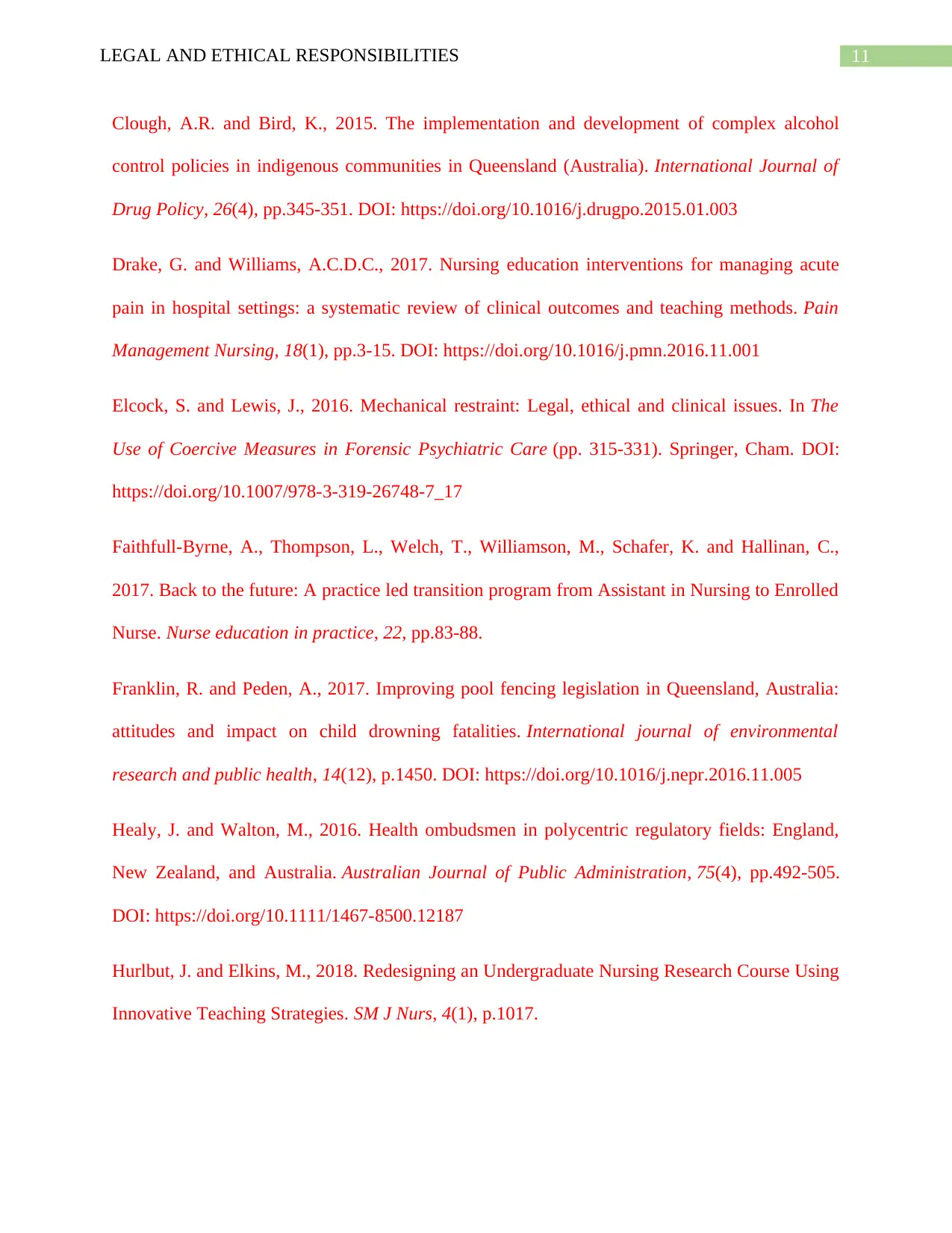
11LEGAL AND ETHICAL RESPONSIBILITIES
Clough, A.R. and Bird, K., 2015. The implementation and development of complex alcohol
control policies in indigenous communities in Queensland (Australia). International Journal of
Drug Policy, 26(4), pp.345-351. DOI: https://doi.org/10.1016/j.drugpo.2015.01.003
Drake, G. and Williams, A.C.D.C., 2017. Nursing education interventions for managing acute
pain in hospital settings: a systematic review of clinical outcomes and teaching methods. Pain
Management Nursing, 18(1), pp.3-15. DOI: https://doi.org/10.1016/j.pmn.2016.11.001
Elcock, S. and Lewis, J., 2016. Mechanical restraint: Legal, ethical and clinical issues. In The
Use of Coercive Measures in Forensic Psychiatric Care (pp. 315-331). Springer, Cham. DOI:
https://doi.org/10.1007/978-3-319-26748-7_17
Faithfull-Byrne, A., Thompson, L., Welch, T., Williamson, M., Schafer, K. and Hallinan, C.,
2017. Back to the future: A practice led transition program from Assistant in Nursing to Enrolled
Nurse. Nurse education in practice, 22, pp.83-88.
Franklin, R. and Peden, A., 2017. Improving pool fencing legislation in Queensland, Australia:
attitudes and impact on child drowning fatalities. International journal of environmental
research and public health, 14(12), p.1450. DOI: https://doi.org/10.1016/j.nepr.2016.11.005
Healy, J. and Walton, M., 2016. Health ombudsmen in polycentric regulatory fields: England,
New Zealand, and Australia. Australian Journal of Public Administration, 75(4), pp.492-505.
DOI: https://doi.org/10.1111/1467-8500.12187
Hurlbut, J. and Elkins, M., 2018. Redesigning an Undergraduate Nursing Research Course Using
Innovative Teaching Strategies. SM J Nurs, 4(1), p.1017.
Clough, A.R. and Bird, K., 2015. The implementation and development of complex alcohol
control policies in indigenous communities in Queensland (Australia). International Journal of
Drug Policy, 26(4), pp.345-351. DOI: https://doi.org/10.1016/j.drugpo.2015.01.003
Drake, G. and Williams, A.C.D.C., 2017. Nursing education interventions for managing acute
pain in hospital settings: a systematic review of clinical outcomes and teaching methods. Pain
Management Nursing, 18(1), pp.3-15. DOI: https://doi.org/10.1016/j.pmn.2016.11.001
Elcock, S. and Lewis, J., 2016. Mechanical restraint: Legal, ethical and clinical issues. In The
Use of Coercive Measures in Forensic Psychiatric Care (pp. 315-331). Springer, Cham. DOI:
https://doi.org/10.1007/978-3-319-26748-7_17
Faithfull-Byrne, A., Thompson, L., Welch, T., Williamson, M., Schafer, K. and Hallinan, C.,
2017. Back to the future: A practice led transition program from Assistant in Nursing to Enrolled
Nurse. Nurse education in practice, 22, pp.83-88.
Franklin, R. and Peden, A., 2017. Improving pool fencing legislation in Queensland, Australia:
attitudes and impact on child drowning fatalities. International journal of environmental
research and public health, 14(12), p.1450. DOI: https://doi.org/10.1016/j.nepr.2016.11.005
Healy, J. and Walton, M., 2016. Health ombudsmen in polycentric regulatory fields: England,
New Zealand, and Australia. Australian Journal of Public Administration, 75(4), pp.492-505.
DOI: https://doi.org/10.1111/1467-8500.12187
Hurlbut, J. and Elkins, M., 2018. Redesigning an Undergraduate Nursing Research Course Using
Innovative Teaching Strategies. SM J Nurs, 4(1), p.1017.
⊘ This is a preview!⊘
Do you want full access?
Subscribe today to unlock all pages.

Trusted by 1+ million students worldwide
1 out of 14
Related Documents
Your All-in-One AI-Powered Toolkit for Academic Success.
+13062052269
info@desklib.com
Available 24*7 on WhatsApp / Email
![[object Object]](/_next/static/media/star-bottom.7253800d.svg)
Unlock your academic potential
Copyright © 2020–2025 A2Z Services. All Rights Reserved. Developed and managed by ZUCOL.




